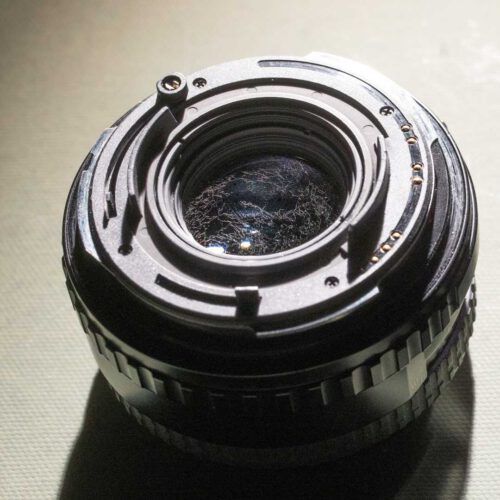Problems with fungus
Fungus is obviously undemanding: it even grows on the lenses of camera lenses. Like cultivated mushrooms, this Fungus Loves a dark environment and high humidity.
I myself have already been confronted with this with a lens that I had carelessly stored in the cellar. Because I am far less critical than others when it comes to impairments of the optical system, I use it and do not notice any visible effects. However, the fungus in this lens only affects a small area of about 3 mm in diameter.
When I was offered a 75 mm lens for my Pentax 645, I bought it for a small amount despite it being badly affected by fungus, but I wondered: what effect would that have?
After unscrewing the rear lens group, I was able to remove some of the heavy infestation, but further disassembly was too risky for me. Therefore, the lens still has a very clearly visible fungus.
After taking a few test shots, including some with high-contrast subjects, I came to the conclusion that the lens is perfectly good for photography – see the two pictures on the right. But of course the question remained: wouldn't it be even better without the fungus?
A Comparison
Actually, I'm not that moved by it, but since I had the opportunity to test a second lens without fungus, I took a closer look at the situation.
My lens shows dense deposits of fungal threads on the front and back, the other has a largely clear glass with a little dust.
I took these two lenses on a little trip and shot the same subject twice at open aperture – once with each lens, and always in the same order. All pictures are on the same film, so that they were all developed at the same time. And to make sure that everything was the same during image processing, I scanned and edited each pair together.
As you can see, there is only a minor difference in brightness between two images. However, the darker of the two images also has a bit more sky in it, which leads to a shorter exposure and explains this difference.
Even in the cropped sections of these images shown below, I can only see small differences in the exact point of focus, but the images do not differ in sharpness and contrast.
All this did not surprise me, because it confirmed what I had already noticed when I tested the first film with the affected lens. And I also know that fog in the lens has a much smaller impact than most people think. With the cheaply purchased lens, I can continue to take pictures without thinking that it might be better after all. So far, I was very satisfied with the test result.
The Problem
So what is my problem? I hadn't noted the order in which I used the lenses. So I can't say whether the first or the second picture was taken with the fungus-affected lens. I probably won't find out, and I don't really need to know.

Sagen Sie uns Ihre MeinungSchreiben Sie einen Kommentar